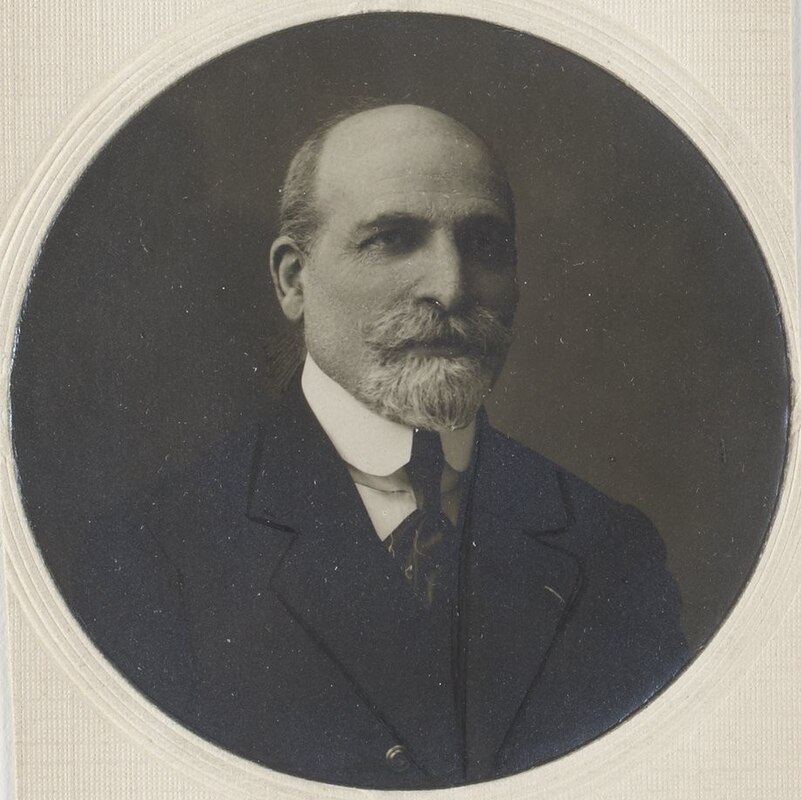Karapet Basmadjian (Կարապետ Պասմաճեան)
Date & Place of Birth
1864 in Polis, Constantinople
Date & Place of Death
17-May-1942 in Paris, France
Biography
Born in Polis (Constantinople). He received his early education at the local tobacco school in his birthplace. In 1880, he was admitted to the medical school in Bolso (Constantinople), subsequently specializing in pharmacology. He completed his studies at the historical research department of the University of Paris. At the same time, he engaged in the study of the languages, history, and philology of the peoples of the Near East. He traveled to countries in the East and studied the languages and customs of the peoples of those countries. Upon returning to Constantinople, he wished to settle there. In Constantinople, he was involved in political movements, was arrested, and imprisoned. After some time, he was released and moved to Paris, where he eventually settled.
From the beginning of the 1890s, he finally devoted himself to philological work. Thereafter, until deep in old age, he was involved with the history of the Armenian people, writing more than ten works in Armenian, French, and English. His first scholarly work, dedicated to the deciphering of Assyrian-Babylonian inscriptions, was published in 1893. This was followed by further studies, all dedicated to deciphering cuneiform inscriptions. From the same years, he collaborated with Armenian scholarly journals ("Bazmavep", "Byurakan", "Anahit", etc.). In 1899, in Paris, he founded the "Banaser" archaeological and historical journal, which continued until 1908. In the pages of "Banaser", his and other historians' Near Eastern, especially Armenian, researches were published. In 1901, he wrote works in Armenian and French on the architectural style of Zvartnots and the cuneiform inscriptions discovered in Zvartnots. From 1899 to 1907, in Paris, he published the "Banaser" historical, philological, and literary journal, in which articles related to Armenian medicine and the history of Armenia were printed. He studied Amirtovlat Amasiatsi's "Unfathomable Doctor" and made translations of its chapters into Latin and French. Subsequently, in Constantinople, Paris, Venice, Vienna, and other cities, he published new books. His notable work contributed to the scientific publication of the manuscripts of ancient Armenian medicine in European state and private libraries.
As a pharmacist and lexicographer, he made significant contributions to the work of translating and interpreting the names of medicines and diseases in Arabic and Armenian into Latin and French. Karapet Basmadjian was the first to outline the history of Armenian dramaturgy with one book. He is the author of numerous articles on the history of Armenian medicine, published in French periodicals. He was also involved in issues of Armenian medical terminology.
Karapet Basmadjian was a member of the Armenian Physicians' Society in Paris and an honorary member of the French Society of Medical Historians. He was awarded the gold medal of the French public educator.
His books worthy of special mention include "The True History of the Armenians" (Constantinople, 1914, 1927), "Dictionary of the Armenian World Language", "General Armenian Numismatics" (Venice, 1936), and others. The detailed bibliography of his works can be found in M. Poturyan's "Armenian Encyclopedia".
He died in 1942 in Paris.
From the beginning of the 1890s, he finally devoted himself to philological work. Thereafter, until deep in old age, he was involved with the history of the Armenian people, writing more than ten works in Armenian, French, and English. His first scholarly work, dedicated to the deciphering of Assyrian-Babylonian inscriptions, was published in 1893. This was followed by further studies, all dedicated to deciphering cuneiform inscriptions. From the same years, he collaborated with Armenian scholarly journals ("Bazmavep", "Byurakan", "Anahit", etc.). In 1899, in Paris, he founded the "Banaser" archaeological and historical journal, which continued until 1908. In the pages of "Banaser", his and other historians' Near Eastern, especially Armenian, researches were published. In 1901, he wrote works in Armenian and French on the architectural style of Zvartnots and the cuneiform inscriptions discovered in Zvartnots. From 1899 to 1907, in Paris, he published the "Banaser" historical, philological, and literary journal, in which articles related to Armenian medicine and the history of Armenia were printed. He studied Amirtovlat Amasiatsi's "Unfathomable Doctor" and made translations of its chapters into Latin and French. Subsequently, in Constantinople, Paris, Venice, Vienna, and other cities, he published new books. His notable work contributed to the scientific publication of the manuscripts of ancient Armenian medicine in European state and private libraries.
As a pharmacist and lexicographer, he made significant contributions to the work of translating and interpreting the names of medicines and diseases in Arabic and Armenian into Latin and French. Karapet Basmadjian was the first to outline the history of Armenian dramaturgy with one book. He is the author of numerous articles on the history of Armenian medicine, published in French periodicals. He was also involved in issues of Armenian medical terminology.
Karapet Basmadjian was a member of the Armenian Physicians' Society in Paris and an honorary member of the French Society of Medical Historians. He was awarded the gold medal of the French public educator.
His books worthy of special mention include "The True History of the Armenians" (Constantinople, 1914, 1927), "Dictionary of the Armenian World Language", "General Armenian Numismatics" (Venice, 1936), and others. The detailed bibliography of his works can be found in M. Poturyan's "Armenian Encyclopedia".
He died in 1942 in Paris.
Collection
Citation
“Karapet Basmadjian (Կարապետ Պասմաճեան),” Armenian Numismatic Research Organization, accessed January 22, 2025, https://armnumres.org/items/show/1594.


